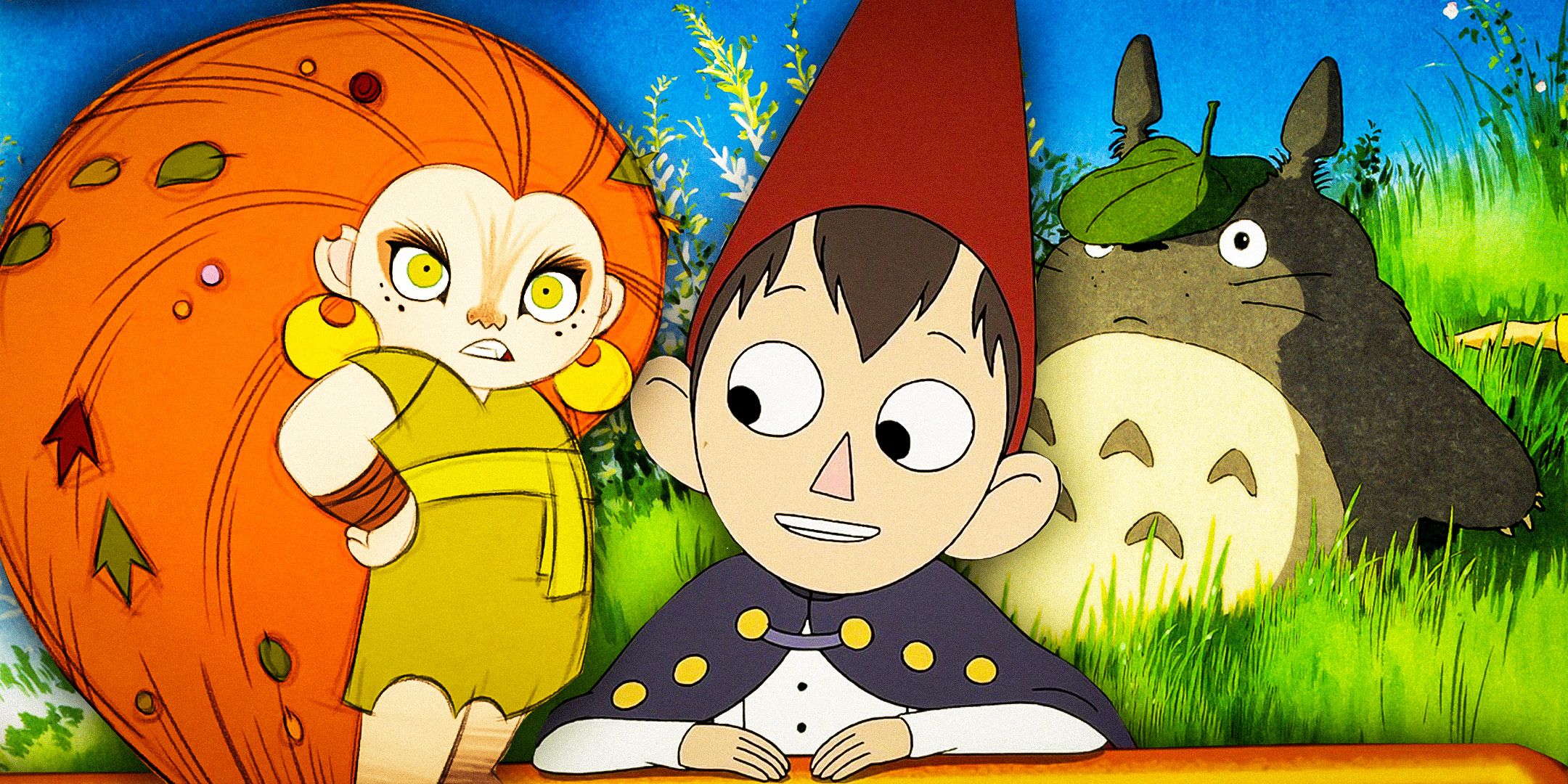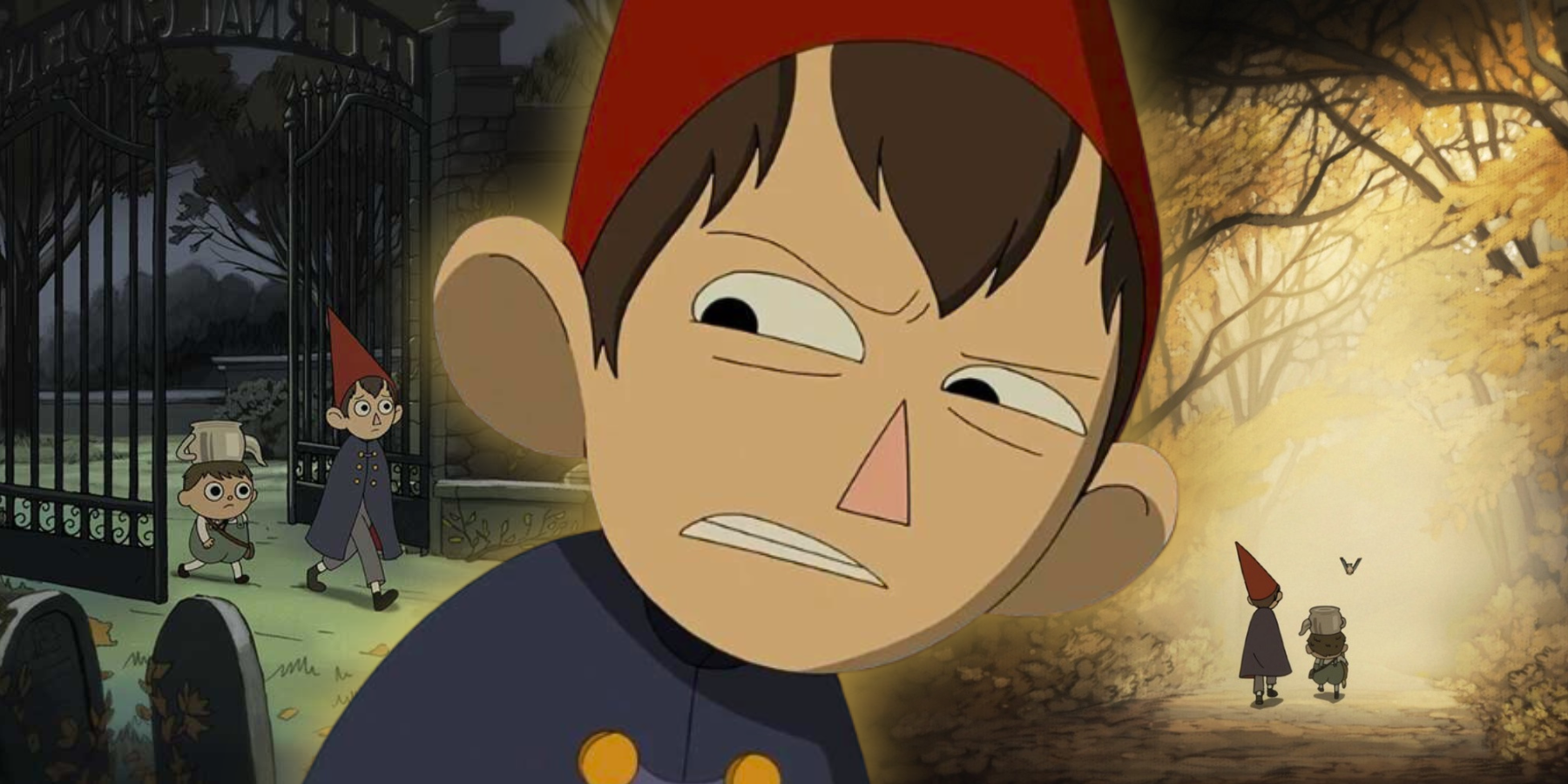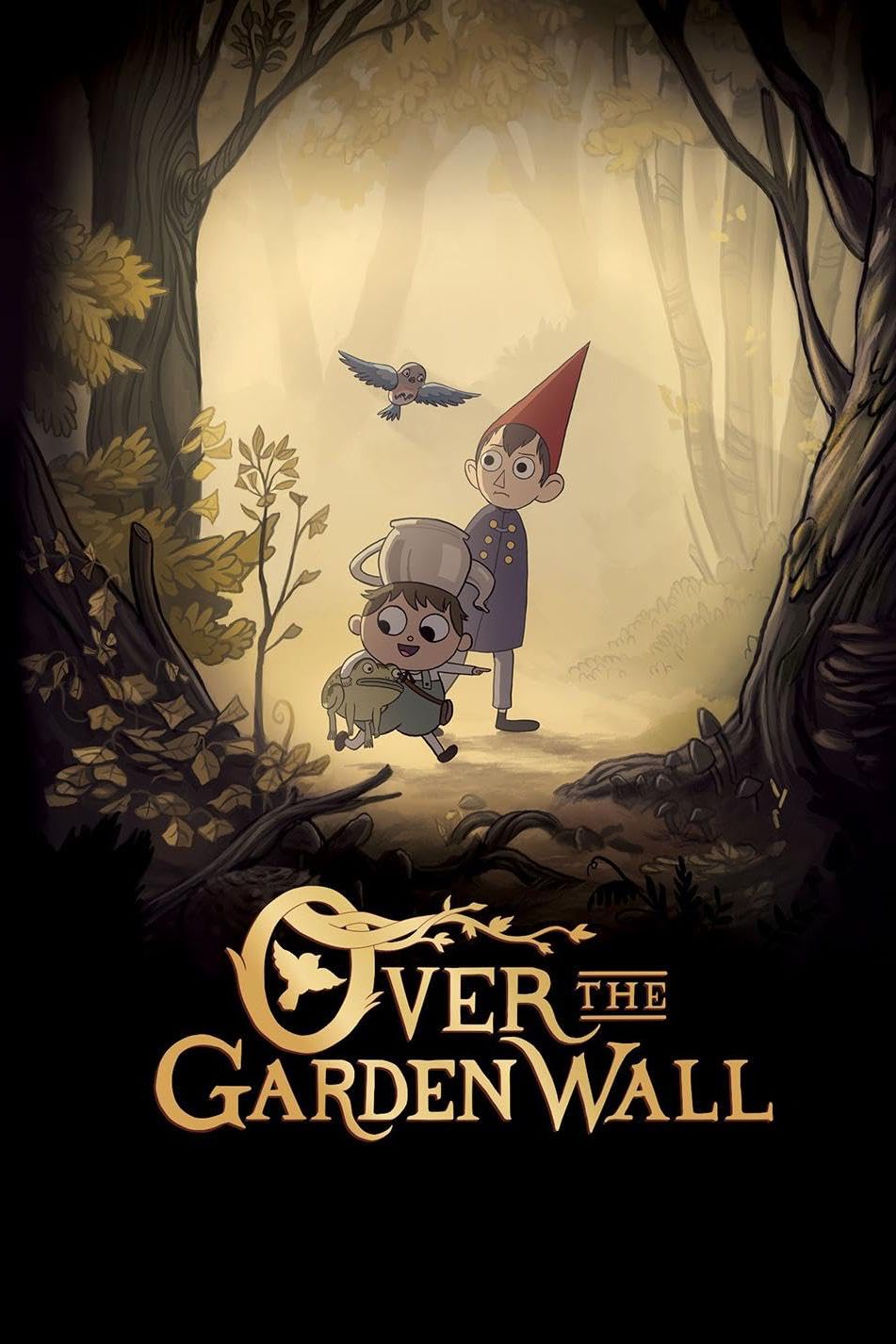This article contains discussion of torture and suicide.
There are many similarities between Over the Garden Wall and Dante Alghieri’s Inferno, but Cartoon Network’s cult classic miniseries actually has a direct counterpart for each of the Italian poet’s nine circles of Hell. Over the Garden Wall is filled with parallels to Dante’s Inferno (via CBR), which is likely a reason the show has had such enduring popularity. In fact, Over the Garden Wall is considered perfect for Halloween, and there’s even a 10th anniversary short for Over the Garden Wall. Dante’s Inferno has stood the test of time for centuries, and it is now a clear inspiration for Over the Garden Wall.
Several of the characters in Over the Garden Wall have direct parallels to figures in Inferno. Wirt is Dante, the poetic traveler who has to overcome his sin. Greg is Virgil, the braver guide through the Unknown and the Inferno, respectively. Interestingly, both stories have characters named Beatrice. One is Dante’s lost love, and the other is the human-turned-bluebird who tries to lure the boys to Adelaide’s house, and they both act as sorts of guides in their respective tales. The parallels don’t end there, however, as each episode of Over the Garden Wall directly correlates to a Circle of Hell in Inferno.
1 The Gates Of Hell – The Old Grist Mill
Dante & Wirt Have Similar Starts To Their Journeys
Neither Dante’s Inferno nor Over the Garden Wall actually start in Hell; they both start at the entrance to the underworld. In Inferno, Dante finds himself in a “gloomy wood,” whereas in Over the Garden Wall, Wirt and Greg find themselves lost in a similarly eerie forest, and none of them could remember how they got there. Then, Dante found himself faced by three beasts: a panther, a lion, and a she-wolf. Wirt and Greg encounter something similar at the old grist mill – Beatrice’s dog, who has been transformed into a savage beast by the black turtles.
Related
Where To Watch Over The Garden Wall
Over the Garden Wall is Cartoon Network’s beloved 2014 miniseries about half-brothers who get lost in the mysterious Unknown. Here’s how to watch it.
Greg and his Inferno counterpart Virgil both end up driving off Wirt and Dante’s beasts, and then leading them deeper into their voyage. The Woodsman seems like a parallel to Dante’s description of the vestibule of Hell, where those who were self-serving and “undecided” in life were punished. In Inferno, the selfish souls were forced to chase an elusive banner that they could never catch, while the Woodsman was forced to cut down Edelwood trees to fuel the Beast’s lantern endlessly, a task which he did to serve his own desire to keep his daughter alive.
2 Limbo, The First Circle – Pottsfield
Limbo & Pottsfield Are Filled With Goodhearted People
Once they entered Hell proper, Dante and Virgil encountered the souls trapped in Purgatory, the First Circle. Over the Garden Wall‘s version of Purgatory is Pottsfield. Purgatory was filled with virtuous Pagans and the unbaptized, people who never had a chance to accept the Christian God into their lives. Meanwhile, Pottsfield is a reference to a “potter’s field,” which was a graveyard used for foreigners and unidentified people. Over the Garden Wall seems to have chosen the name Pottsfield specifically to draw parallels between the town’s residents and the souls who end up in Purgatory.
The residents of Pottsfield are not cruel or mean, and though they don’t seem to be able to leave the Unknown, they aren’t paying for a particular sin.
Notably, neither Purgatory nor Pottsville was meant to be an especially tortuous layer of Hell or the Unknown. Dante filled Purgatory with some of the greatest “heathen” thinkers and figures in history, such as Aristotle and Julius Caesar. The second part of The Divine Comedy, Purgatorio, explains that the souls in Purgatory were allowed to leave and enter heaven by repenting, usually through prayer. Likewise, the residents of Pottsfield are not cruel or mean, and though they don’t seem to be able to leave the Unknown, they aren’t paying for a particular sin.
3 Lust, The Second Circle – Ms. Langtree’s School
Ms. Langtree & The Animals Are Ruled By Their Desires
As a kid’s show, Over the Garden Wall had to get creative with how it depicted the Second Circle of Hell, which was reserved for those who were slaves to lust. According to Dante, lust was inherently sexual, but it was also a sin committed by people who were unable to resist their bodily desires and overindulged in earthly pleasures. So, Over the Garden Wall depicts lust in two ways: through Ms. Langtree and Jimmy Brown and through the animals at the school.
Ms. Langtree and Jimmy Brown are the more straightforward interpretation of Dante’s concept of lust. Ms. Langtree is obsessed with Jimmy, and often breaks into spontaneous song to bemoan her lost love. She’s consumed by her earthly desire for love, and while she isn’t explicitly talking about sex, there’s a clear connection to lust in the way she desires Jimmy. The animals, however, serve as a less direct example of lust. They symbolize the idea that lust is about submitting to bodily desires, much like an animal has no notion of anything beyond immediate needs like food, safety, and reproduction.
4 Gluttony, The Third Circle – The Tavern
The Tavern Goers In Over The Garden Wall Are Obsessed With Getting More Business
Dante’s Third Circle, gluttony, has the most abstract representation in Over the Garden Wall. In Inferno, gluttonous sinners are forced to live in a sort of rotting muck and endure icy rain. They’re also constantly assailed by Cerberus, a figure from Greek mythology who is most commonly depicted as a three-headed dog. Meanwhile, in Over the Garden Wall, Wirt, Greg, and Beatrice come upon a tavern on a rainy night. The tavern door is also kept shut by a sleeping dog, and that dog rushes to close the door behind everyone who enters or leaves.
Over the Garden Wall‘s connections to the Third Circle aren’t very strong, but they are present. There’s a sense that the tavern itself is a symbol of gluttony, in that it’s a place where the townsfolk gather to indulge in food and drink. Later on in Inferno, Dante even mentions “gluttons at the tavern’s mess,” which makes the setting seem more pertinent. The dog at the tavern could also represent Cerberus. The closest the series gets to showing the tavern goers as gluttonous, however, is through the song about Wirt’s wedding, where they try to get as much business out of him as possible.
5 Greed, The Fourth Circle – Quincy Endicott’s Manor
Quincy Endicott Admits He Is Greedy & His
Dante’s Fourth Circle, Greed, has one of the more overt representations in Over the Garden Wall. Quincy Endicott is clearly afflicted by the sin of greed, and he says so himself numerous times throughout the episode. When speaking to Wirt and Greg, Quincy often says things like “enjoy my unnecessary excess of wealth and luxury,” which makes it fairly clear that he’s an avaricious person. Quincy doesn’t just fit Dante’s definition of the average denizen of the Fourth Circle of Hell, though, he also fits the punishment inflicted upon them.
The Fourth Circle was reserved for two types of greedy people: those who hoarded wealth, and those who spent it frivolously. In Inferno, the two types of greedy people were forced to battle endlessly by rolling massive weights at each other. In Over the Garden Wall, Quincy Endicott and Margueritte Gray serve this function. The two both hoard their wealth and spend it frivolously – their mansions are so massive that they connect to each other without either aristocrat even noticing. They’re also both involved in the tea industry, and even refer to each other as competitors, which mimics Dante’s depiction of greedy people fighting one another.
6 Wrath, The Fifth Circle – The Ferry Boat
Dante Travels The River Styx, While Wirt & Greg Ride A Riverboat Ferry
Like lust, wrath, the Fifth Circle in Inferno, had to be depicted cleverly to keep Over the Garden Wall suitable for children. The Fifth Circle is situated upon the River Styx, while Over the Garden Wall takes place on a riverboat. The sinners in the Fifth Circle are separated into two groups: the actively wrathful, who are forced to stand in the swampy waters of the Styx and fight one another, and the passively wrathful, who are submerged in the muck and left to their sulking. Over the Garden Wall depicted both versions rather creatively.
The passive sinner is Wirt, who angrily complains to Beatrice about Jason Funderberker stealing Sarah away from him.
In Over the Garden Wall, the actively wrathful sinners are the frog passengers of the ferry. When Wirt stops the music, they devolve into cries and fighting among themselves. The passive sinner is Wirt, who angrily complains to Beatrice about Jason Funderberker stealing Sarah away from him. There’s even a direct reference to the wallowing passive sinners in the Fifth Circle: the frogs jump into a mud puddle. The Fifth Circle was also the last layer that punished sins associated with giving in to base desires, while the later layers are sins made by conscious decision. Using frogs instead of humans could be referencing those base desires.
7 Heresy, The Sixth Circle – Auntie Whispers’ House
Auntie Whispers & Lorna Seem Like Witches, Who Populated Dante’s Sixth Circle
The Sixth Circle of Hell was reserved for heretics, and Over the Garden Wall took an interesting approach to that sin. The Sixth Circle was, for the most part, filled with ordinary heretics, people who held views that directly contradicted Church teachings and Christian doctrine. However, witches and those who practiced magic were also considered heretics, and Over the Garden Wall uses them to connect to Inferno. Both Lorna and Auntie Whispers evoke imagery of Puritanical women, which was the same period the Salem Witch Trials occurred in. Lorna was also actually possessed by a spirit, which would make her quite like a witch.
Both Lorna and Auntie Whispers evoke imagery of Puritanical women, which was the same period the Salem Witch Trials occurred in.
Over the Garden Wall also makes a less literal allusion to Dante’s Inferno. The punishment given to the heretics of the Sixth Circle was to be locked in a flaming tomb. Auntie Whispers and Lorna, the show’s witches, essentially isolated themselves from the outside world and locked themselves in a sort of tomb. Auntie Whispers also warns Wirt and Greg about Adelaide and the deeper levels of the Unknown, much like Virgil warns Dante about the deeper layers of Hell in the Sixth Circle.
8 Violence, The Seventh Circle – The Forest
Dante Believed Suicide Victims Went To Hell & The Edelwood Trees Represent Suicide
One of the darkest aspects of Over the Garden Wall, its allusions to and symbolism of suicide, represents the Seventh Circle of Hell, violence. In Over the Garden Wall, the Edelwood trees can easily be interpreted as a representation of suicide. The Beast preys upon children who are lost in the woods, and he convinces them to let go of all hope of escape. Once they do, they die and turn into Edelwood trees, and their decision to let go of hope bears quite a few resemblances to many real-life suicides. Viewing the Edelwood trees as suicide victims lets Over the Garden Wall make perhaps its most direct allusion to Inferno.
Viewing the Edelwood trees as suicide victims lets Over the Garden Wall make perhaps its most direct allusion to Inferno.
In Inferno, the Seventh Circle is divided into three rings: the first is filled with people who commit violence to their neighbors, like Atilla the Hun, while the third is filled with those who commit violence against God, art, and nature, like blasphemers or, in keeping with customs in the fourteenth century, sodomites. The second ring, however, is reserved for those who commit violence to themselves -suicide victims – who are turned into trees and fed upon by harpies, mythical women-bird hybrids. The parallels to Over the Garden Wall‘s Edelwood trees, which are formed from suicide victims and harvested by the Woodsman, are clear.
Wirt and Greg’s arrival in the forest also mirrors Dante’s journey. The first ring of the Seventh Circle of Hell is a river of boiling blood, and Over the Garden Wall episode 8 begins with Wirt and Greg paddling down a river. Greg’s dream isn’t an exact adaptation, though it shares some clear imagery. For instance, the dream includes one of the few depictions of violence in the show, when Greg fights the North Wind, and it also has several angelic figures. Additionally, the city of clouds could be a reference to the third ring’s punishment, which was to douse sinners in rain made of fire.
9 Fraud, The Eighth Circle – The Real World
Wirt & Greg Both Committed Forms Of Fraud Before Entering The Unknown
Each sin depicted in Dante’s vision of Hell gets progressively worse as it descends. Dante considered fraud, the sin punished in the Eighth Circle, to be one of the worst things a person could do, and he damns it more thoroughly than murder. It’s helpful to consider what Dante was trying to accomplish with The Divine Comedy. At several points in the poem, he specifically targets real people and uses them to expose corruption. As such, he makes fraud one of the most grievous sins one could commit, as Dante considered corruption a form of fraud that destroys entire societies or organizations, like the Church.
Over the Garden Wall doesn’t share Dante’s depiction of corruption as a form of fraud, but it does utilize a version of fraud. In the real world, both Wirt and Greg committed some form of fraud on Halloween. Wirt was desperately trying to look cool to impress Sarah, which could be considered a type of fraudulent personality. Meanwhile, Greg stole a rock from Old Lady Daniels, and Dante lumps simple thieves in with the fraudsters punished in the Eighth Circle. Neither of the brothers are necessarily the main group Dante was targeting, but they do meet the requirements to be considered fraudsters.

Related
10 Best Movies & TV Shows For Fans Of Over The Garden Wall
Although Over the Garden Wall is incredibly unique, several other movies and TV shows have similar ambiances, themes, and animation styles.
Dante’s description of the Eighth Circle is also represented in Over the Garden Wall. Each of the ten types of fraudsters he identifies are sorted into trenches, and Dante and Virgil travel from one to the next by sliding down each trench’s walls. Likewise, Wirt and Greg enter the Unknown by jumping off a graveyard wall and subsequently falling down a hill. They then fall into a presumably ice-cold river, which leads them to the final Circle of Hell.
10 Treachery, The Ninth Circle – The Beast
The Beast Bears A Striking Resemblance To Satan & Tries To Trick Wirt
The lowest Circle of Hell in Dante’s Inferno is also where Satan resides, and it is reserved for those who are guilty of treachery. Dante describes the Ninth Circle as a frozen lake where traitors are trapped in the ice. The lake is divided into four circles, and the center of the circles is where Lucifer, also known as Satan, is trapped in the ice as punishment for betraying God. Dante also took care to depict Satan as having three faces of different colors, which is important for Over the Garden Wall‘s connection.

Related
Over The Garden Wall’s Story & True Meaning Explained – Was It All A Hallucination?
In the miniseries Over the Garden Wall, half-brothers Wirt and Greg venture through mysterious woods to get home — but what does the ending mean?
In the finale of Over the Garden Wall, Wirt and Beatrice confront the Beast in the middle of a wintry forest, much like the frozen lake. The Beast tries to convince Wirt to take the Woodsman’s place as the keeper of the lantern to save Greg’s life, but Wirt figures out the truth instead. Wirt realizes that the Beast is trying to trick him, as the Beast’s soul is in the lantern, not Greg’s or the Woodsman’s daughter’s. The Beast’s lie is a form of treachery, as he preyed upon the Woodsman’s trust to his detriment. As such, there’s a clear connection to the Ninth Circle.
After the Beast’s treachery is exposed, the Woodsman illuminates the Beast and shows that his body is made of several disfigured faces. That already sounds extremely similar to Dante’s description of Lucifer and his three faces. Additionally, Greg was trapped motionless in a growing Edelwood tree, while the sinners in Inferno were trapped in ice. Luckily, Over the Garden Wall continued its adaptation of Dante’s Inferno, and Wirt and Greg were able to escape the Beast’s clutches just as Dante and Virgil escaped Lucifer’s.
Sources: CBR, Project Gutenberg, Dante Today






